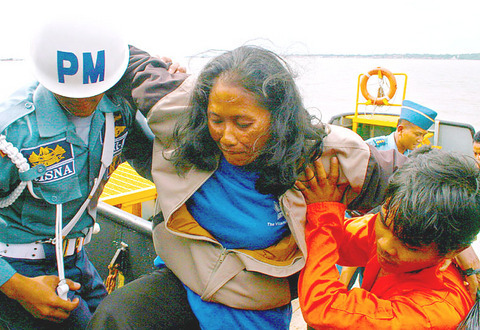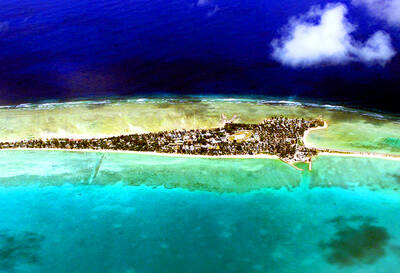Twelve people on board a ferry that sank four days ago in Indonesia's Java Sea were found alive yesterday after clambering onto an unmanned offshore oil rig, navy officers said.
The survivors, all male, were weak but well and expected to arrive on shore later yesterday, said Navy spokesman Lieutenant Colonel Tony Syaiful, who monitored the rescue operation just after midnight from land via radio.
Navy Colonel Jan Simamora, the head of the search and rescue mission, confirmed the rescue.

PHOTO: EPA
Authorities say 628 people were onboard the ferry when it sank late on Friday after being pounded by waves for 10 hours during a violent storm en route from Indonesia's section of Borneo island to the main island of Java.
At least 212 people have been found alive so far, most of them plucked from life-rafts or clinging on to debris, but some 400 remain missing, Simamora said.
"We are trying our utmost to find more," Simamora said. "We still hope that those in lifeboats are still alive."
People in life-rafts or holding on to some form of buoyancy aid can survive for days in Indonesia's warm tropical waters.
Simamora said that 12 bodies have recovered. Officials have reported seeing some corpses in the ocean, while at least two survivors said that many of the victims were trapped in the ship when it sank.
The 12 men rescued yesterday had drifted around 200km from where the ferry sank before coming across the rig, Syaiful said.
Relatives of the missing have flocked to hospitals and ports along Java's coast, hoping their loved ones may turn up alive.
The Senopati Nusantara was built in Japan in 1992 and had a capacity of 850 people.
Officials say bad weather was the cause of the accident, one of several deadly maritime incidents in Indonesia in recent weeks.
Another ferry survivor said that body after body had been dumped from his life raft as people died before help could arrive.
"I was very sad when I had to get rid of the bodies. But I didn't know what else to do with so many dead bodies," said Leopold Kafares, 35, from Flores island.
He was speaking at a hospital in Surabaya, East Java where he was being treated after being picked up at sea.
Kafares said when the ferry ran into trouble in rough seas passengers scrambled for life buoys or space in life rafts.
Just as the ship was capsizing, "I found a life raft in front of me. I struggled to get into the craft with four other people," he said.
But the others died in the rough weather conditions and with food and fresh water lacking, as did more people he helped pull into the raft later, he said.
Some survivors are still on life rafts in the open water, with food being airdropped to them as rough seas and bad weather prevented rescue craft from reaching them.
Search and rescue efforts involving military, government agency and civilian vessels, planes and helicopters have focused on saving lives first over recovering the dead.
Another survivor at the Surabaya hospital, Refi Setiawan, a 29-year-old from Central Java, said ferry passengers were screaming hysterically as the ship started to list.
"Panic peaked when water got to the deck. The ship slanted to the left but in a few seconds it slanted to the right and immediately capsized," he said.
"I, thank God, was able to hold onto a wooden panel until a fisherman helped me. I thought I was dead" after sweltering tropical heat, downpours and being tossed about in the rough seas, said Setiawan.
High waves and strong sea currents were pushing the bodies of the dead and the living eastward in the direction of Surabaya,rescue coordinator Eko Prayitno said.

DISASTER: The Bangladesh Meteorological Department recorded a magnitude 5.7 and tremors reached as far as Kolkata, India, more than 300km away from the epicenter A powerful earthquake struck Bangladesh yesterday outside the crowded capital, Dhaka, killing at least five people and injuring about a hundred, the government said. The magnitude 5.5 quake struck at 10:38am near Narsingdi, Bangladesh, about 33km from Dhaka, the US Geological Survey (USGS) said. The earthquake sparked fear and chaos with many in the Muslim-majority nation of 170 million people at home on their day off. AFP reporters in Dhaka said they saw people weeping in the streets while others appeared shocked. Bangladesh Interim Leader Muhammad Yunus expressed his “deep shock and sorrow over the news of casualties in various districts.” At least five people,

ON THE LAM: The Brazilian Supreme Court said that the former president tried to burn his ankle monitor off as part of an attempt to orchestrate his escape from Brazil Former Brazilian president Jair Bolsonaro — under house arrest while he appeals a conviction for a foiled coup attempt — was taken into custody on Saturday after the Brazilian Supreme Court deemed him a high flight risk. The court said the far-right firebrand — who was sentenced to 27 years in prison over a scheme to stop Brazilian President Luiz Inacio Lula da Silva from taking office after the 2022 elections — had attempted to disable his ankle monitor to flee. Supreme Court judge Alexandre de Moraes said Bolsonaro’s detention was a preventive measure as final appeals play out. In a video made

It is one of the world’s most famous unsolved codes whose answer could sell for a fortune — but two US friends say they have already found the secret hidden by Kryptos. The S-shaped copper sculpture has baffled cryptography enthusiasts since its 1990 installation on the grounds of the CIA headquarters in Virginia, with three of its four messages deciphered so far. Yet K4, the final passage, has kept codebreakers scratching their heads. Sculptor Jim Sanborn, 80, has been so overwhelmed by guesses that he started charging US$50 for each response. Sanborn in August announced he would auction the 97-character solution to K4

SHOW OF FORCE: The US has held nine multilateral drills near Guam in the past four months, which Australia said was important to deter coercion in the region Five Chinese research vessels, including ships used for space and missile tracking and underwater mapping, were active in the northwest Pacific last month, as the US stepped up military exercises, data compiled by a Guam-based group shows. Rapid militarization in the northern Pacific gets insufficient attention, the Pacific Center for Island Security said, adding that it makes island populations a potential target in any great-power conflict. “If you look at the number of US and bilateral and multilateral exercises, there is a lot of activity,” Leland Bettis, the director of the group that seeks to flag regional security risks, said in an